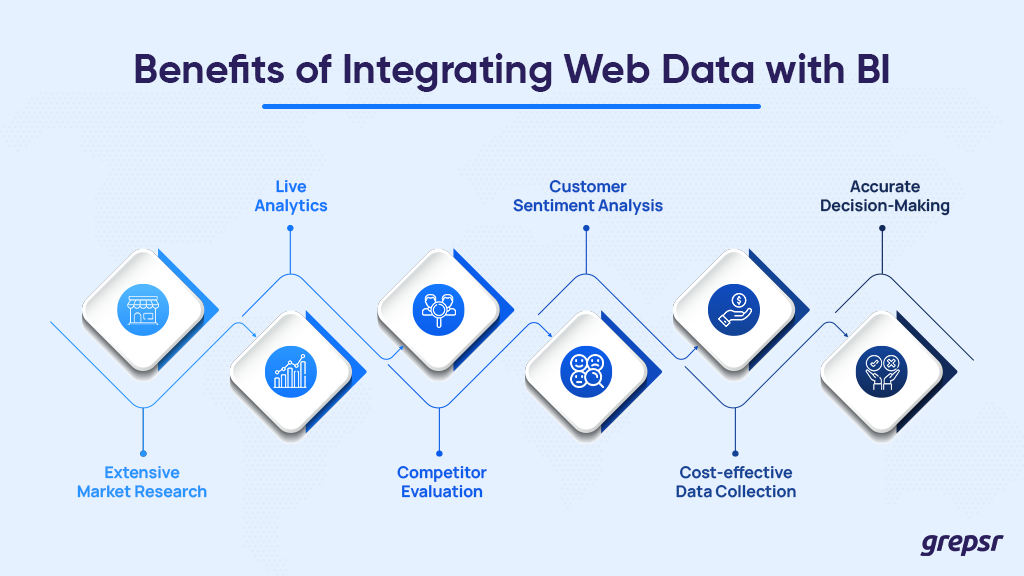
Every company needs to regularly conduct a business analysis. You need your data to be structured and reliable for that purpose. One of the best techniques for collecting information is data scraping. It gives you an opportunity to extract details about market trends, competitors, and much more.
Today, we want to talk more about business intelligence tools. We’ll discuss how incorporating web-scraped data into them can benefit you. Keep reading and learn how all of this can influence the quality of your decisions.
About Business Intelligence Tools
First, we want to explain what business intelligence tools are. They give you an opportunity to analyze and visualize data. Your decisions can become more strategic with its help.
At its core, Business Intelligence refers to different processes and technologies. They aid you with the collection and presentation of all kinds of information. BI lets you convert it into meaningful insights. Below we gathered some of its key components.
Data Integration
This process depends on the integration of data from disparate sources. These include
- Databases
- Spreadsheets
- External platforms, etc
This integration allows you to create a unified and accessible repository for complete analysis.
Analysis
The ability to properly analyze this info is central for BI. Advanced analytics capabilities allow you to explore trends and identify patterns. You can use different techniques for that, like
- Statistical analysis
- Data mining
- Predictive modeling
Visualization
Visualization instruments can help you transform complex data sets into visuals you can easily understand. Elements like charts, graphs, and interactive dashboards can improve your presentations. They’ll make it easier for you to interpret and act upon this info.
Reporting
BI instruments generate reports that showcase KPIs and other important metrics. This automated reporting gives you the possibility to access relevant details right away. That way you can respond to changing circumstances quicker.
Dashboarding
Another critical component is dynamic dashboards. They can give you live snapshots of your performance. They allow you to monitor different tendencies and track goals. You can gain a full view of all your business operations through them.

Querying and Reporting
Also, these tools allow you to interact with data through querying and reporting functionalities. You can use these functions to
- Extract specific details
- Create ad-hoc reports
- Customize the analyses
Metadata Management
Metadata includes details about the source, format, and context of data. Its proper management is really important for BI. It ensures that the info you analyze is accurate and consistent.
Warehousing
You also need a central repository to store and manage large volumes of data you gathered. Proper warehousing allows you to retrieve data at any time. It supports all your analytical processes.
We also want to mention some of the popular BI tools. These are
- Tableau
- Power BI
- QlikView
- Looker
- MicroStrategy
- Sisense
- Domo, and more…
Principles of Web Scraping
As we have already mentioned, data analysis is extremely valuable for any business. One of the best ways to extract it is web scraping. We want to explain how you can implement this technique.
Identify Data Sources
First of all, you need to determine the specific websites and online sources from which you can extract information. For example, you can use
- Competitor websites
- Social media platforms
- Industry forums, and more…
Understand Website Structure
Then you have to comprehend the structure of the target sites. You need to know the principles of HTML, CSS, or JavaScript elements. It’ll allow you to locate and pull the desired info.
Respect Terms of Service
Remember, that it is necessary to adhere to ethical and legal considerations. There’s a “robots.txt” file on websites. It can give you guidelines on web crawling.
Use Reliable Tools (or Services)
The next step is to choose the right web scraping instruments. Some of the popular alternatives are
- BeautifulSoup
- Scrapy
- Grepsr
- Selenium, etc.
Handle Dynamic Content
Keep in mind that many modern sites use dynamic content loaded through JavaScript. You have to be capable of handling such elements.
Cleaning and Validation
We want to mention that web-scraped data may contain inconsistencies or errors. So, you have to clean and validate all the info. That way the results of your practices will be more reliable.
You can incorporate web-scraped data into your BI. We will explain how you can do it below. Here we want to mention some benefits it can give you.

Step-by-Step Guide to Integration
We have already defined that web scraping can be really beneficial for you. This process can improve the capabilities of your BI tools. Below, we gathered the steps of incorporating this procedure.
Define Objectives and Scope
First, you have to clearly outline the objectives of this integration. Identify the specific data sources you want to use. We mentioned some of the options above. Then you need to determine the scope of the information you want to extract.
Choose the Right Web Scraping Instruments
Next, you need to select a reliable tool that aligns with your goals. There are a variety of options available. Some of them are more suitable for complex tasks. Make sure that the chosen instrument can handle the volume of data you expect. Also, pay attention to the format it deals with.
Learn about Terms of Services and Legal Implications
You should thoroughly review the terms of service of each site before you scrape data. Be aware of any legal implications surrounding this procedure. For instance, you need to pay attention to copyright laws and data privacy regulations.
Colin McDermott, Head of SEO at Whop advises that “anyone considering scraping on behalf of a company, should always consider the jurisdiction you and the website you are considering scraping are based in, and any applicable laws that may apply. In the US – some courts have considered that unauthorized scraping can sometimes come under the CFAA regulations. So if you can get permission to scrape the website that is of course always preferable.”
Design Data Extraction Process
Then you have to develop a systematic approach to extraction. Some of the steps may be
- Identifying HTML elements
- Setting up automated scripts
- Handling pagination for large datasets, etc.
Remember to regularly test and refine your processes to maintain accuracy.
Clean and Validate Data
As we’ve highlighted before, raw data may have inaccuracies or mistakes. You have to review and validate it to confirm it’s trustworthy. Make sure to address missing or duplicate points. Also, you need to standardize formats and handle outliers.
Transform Info for BI Compatibility
Next, you have to convert the info you gathered into a structured and compatible format. It’s necessary to make sure it matches the requirements of your platform. Some actions you can take are
- Aggregation
- Filtering
- Enrichment, etc.
Choose a BI Tool
Then, pick a BI instrument that suits your organization’s needs. We suggested some alternatives above. Make sure it supports the formats and sources you got through web scraping. Remember that it needs to have the proper connectors or APIs for integration.
Establish Integration Pipeline
Also, you have to create a pipeline that connects your data with the chosen tool. For instance, you may
- Set up scheduled updates
- Employ immediate integration
- Handle data refreshes and more…
Implement Security Measures
It’s really important to guarantee proper protection. For example, you can use encryption or access controls. It’ll help you safeguard any sensitive information. Make sure to keep up with legal and ethical norms.
Monitor and Iterate
You have to regularly monitor the data after you complete the integration. Implement feedback loops such as sending out regular feedback forms to refine all the processes. Also, make sure to keep up with any changes in website structures.
Challenges
Even though this incorporation can be really helpful, there might be some difficulties. You need to know about several challenges you may face. We collected some of them below.
Data Quality and Accuracy
This type of data may vary in quality. You may need to handle certain inaccuracies. As we’ve mentioned, validation is a must. However, it may be hard to maintain precision.
Website Structure Changes
Sites frequently undergo changes in their layouts or data presentation methods. These alterations can disrupt your existing web scraping scripts. It may lead to different errors. You need to regularly make some adjustments to avoid that.
Anti-Scraping Measures
Some web pages employ these measures to protect their data. You may need some advanced techniques and instruments to overcome these obstacles. This can make your web-scraping process much more complicated.
Volume and Scalability
It can be hard to manage a lot of data when you scale your efforts. You may need to invest more in additional infrastructure and optimization strategies.
Integration Complexity
As we’ve mentioned this data may come in various forms. BI tools often have specific requirements. So, combining them can be a complex task. The standardization process can be pretty difficult and time-consuming.
Dependency on Third-Party Websites
Keep in mind that web scraping is inherently dependent on the stability of third-party sites. Changes in their policies, shutdowns, or downtime can disrupt your efforts.
Conclusion
There’s no doubt that regular business analysis is necessary for any company. There are different instruments and procedures for that purpose. Business intelligence tools stand out among them. They simplify the analytics process and allow you to explore some noteworthy points.
Web-scraped data can boost the capacities of these tools even more. So, consider incorporating it into your BI strategies. It can result in more accurate and strategic decisions. However, you need to remember there might be some difficulties on your way. You need to keep up with any changes and all the legal requirements.
We hope that you found our guide helpful. Don’t hesitate to try out new combinations. This integration may benefit you in many ways.







